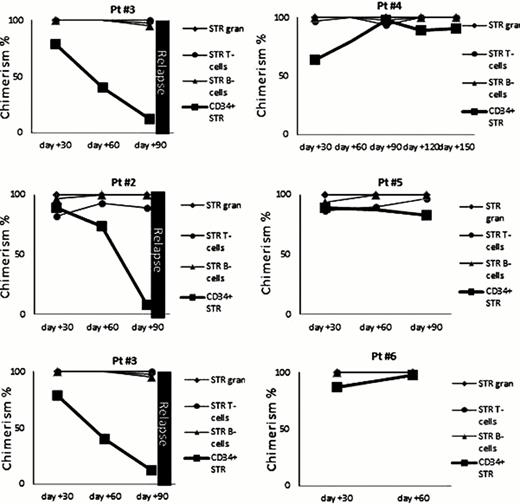Abstract
Abstract 3074
Disease relapse after allogeneic hematopoietic stem cell transplant (HCT) remains a major obstacle to treatment success and cure for patients with myelodysplastic syndromes (MDS) and acute myelogenous leukemia (AML). Early identification of patients at a high risk for disease relapse has significant practical implications allowing early therapeutic interventions. We evaluated a novel approach for an early identification of a post-transplant relapse in patients with MDS and AML.
CD34+ specific donor chimerism analysis was obtained in 6 HCT recipients with CD34+ AML and MDS. Starting at day +30 post HCT CD34+ cells from peripheral blood were positively selected by immunomagnetic isolation and then underwent fluorescence-activated cell sorting. Purified CD34+ cells were subsequently evaluated for percentage of donor DNA contribution by short tandem repeat (STR) analysis. CD34+ specific donor chimerism analysis was repeated monthly until hematologic relapse or death occurred. Simultaneously, conventional donor chimerism analysis was measured in the subpopulations of peripheral blood cells.
CD34+ cells were isolated from peripheral blood with a very high purity >95% and in sufficient quantity for reliable STR analysis in all study patients. Out of 6 evaluated patients, 3 developed hematologic relapse confirmed by bone marrow evaluation. In each relapsed patient CD34+ specific chimerism dropped to <15% prior to the confirmation of hematologic relapse. However, conventional STR analysis in granulocytes, T-cells and B-cells remained >80% (Figure 1). Moreover, obvious and steady decline in CD34+ specific donor chimerism significantly preceded the time of hematologic relapse. In contrast, no decline in CD34+ chimerism was identified in 3 patients without hematologic relapse. (Figure 1).
Though this is a preliminary study, the results suggest that CD34+ specific donor chimerism analysis is a useful technique for timely identification of hematologic relapse in MDS and AML patients after HCT and may provide significantly earlier relapse detection than conventional chimerism analysis.
Conventional and CD34+ donor chimerism monitoring in patients with (left column) and without (right column) hematologic relapse
Conventional and CD34+ donor chimerism monitoring in patients with (left column) and without (right column) hematologic relapse
No relevant conflicts of interest to declare.
Author notes
Asterisk with author names denotes non-ASH members.


This feature is available to Subscribers Only
Sign In or Create an Account Close Modal